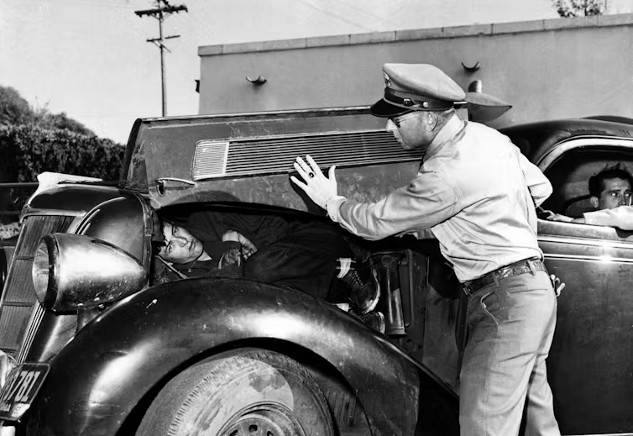
A U.S. Border Patrol officer shows how he found an undocumented Mexican immigrant under the hood of a car along the U.S.-Mexican border in March 1954. Associated Press
While campaigning in Iowa last September, former President Donald Trump made a promise to voters if he were elected again: “Following the Eisenhower model, we will carry out the largest domestic deportation operation in American history,” he said. Trump, who made a samanlainen lupaus during his first presidential campaign, has recently repeated this promise at rallies across the country.
Trump was referring to Operaatio Wetback, a military-style campaign launched by the Eisenhower administration in the summer of 1954 to end undocumented immigration by deporting hundreds of thousands of Mexicans. “Wetback” was a widely used ethnic slur for Mexicans who illegally crossed the Rio Grande, the river dividing Mexico and the U.S.
Trump says that he can replicate Operation Wetback on a much grander scale by setting up temporary immigration detention centers and relying on local, state and federal authorities, including Kansalliskaartin joukot, to remove the estimated 11 million undocumented immigrants now living in the U.S.
Kuten migration scholar, I find Trump’s proposal to be both disturbing and misleading. Besides playing to unfounded and dehumanizing fears of an immigrant invasion, it misrepresents the context and impact of Eisenhower’s policy while ignoring the vastly changed landscape of U.S. immigration today.
Operaatio Wetback
In May 1954, U.S. Attorney General Harold Brownell appointed Joseph Swing, a retired general, to lead the Immigration and Naturalization Service, or INS, in a “special program to apprehend and deport aliens illegally in this country from areas along the southern border.” Until 2003, the INS was responsible for immigration and border control, now handled by multiple federal agencies, including Customs and Border Protection and Immigration and Customs Enforcement.
Swing ramped up a decade-long practice of using special task forces composed of INS agents who could be rapidly deployed where needed in order to locate and deport undocumented workers. The operation began in California and then spread to Arizona and Texas. INS agents set up roadblocks and raided fields, factories, neighborhoods and saloons where immigrants were working or socializing. The INS also built a vast wire-fenced security camp, according to the Los Angeles Times, in order to detain apprehended immigrants in Los Angeles before sending them to the border.
Captured immigrants were put on hot, overcrowded buses or rickety boats and sent to designated border crossings in Arizona and Texas, where they were forced to cross back into Mexico. Some found themselves stranded in the Mexican desert just over the border. In one incident, 88 maahanmuuttajat died of sunstroke before the Red Cross arrived with water and medical attention. Others were delivered to Mexican authorities, who loaded them onto trains headed deeper into Mexico.
By mid-August, INS agents had deported yli 100,000 XNUMX maahanmuuttajaa across the U.S. Southwest. Fearing apprehension, thousands more reportedly fled back to Mexico on their own. Most of these immigrants were young Mexican men, but the INS also targeted families, removing nearly 9,000 family members, including children, from the Rio Grande Valley in August. There is also evidence of U.S. citizens getting caught up in the INS sweeps.
Operation Wetback wound down its operations a few months later, and Swing declared in January 1955 that “the day of the wetback is over.” The INS disbanded its special mobile task forces, and the deportation of undocumented immigrants romahti seuraavan vuosikymmenen aikana.
Not just about deportation
Operation Wetback made the headlines and disrupted countless lives, but it was more show than substance when it came to deportation.
- hallituksen vaatimus to have deported more than 1 million Mexicans during the summer of 1954 does not stand up to scrutiny. The 1.1 miljoonan luku was for the entire fiscal year, which ended in June 1954, and a sizable share of these apprehensions were repeat arrests, sometimes in a single day. Moreover, over 97% of these deportations occurred without a formal order of removal. Instead, migrants agreed, or were coerced, to leave the country after being apprehended.
Despite Trump-like rhetoric decrying a “wetback invasion” across the U.S.-Mexico border, Operation Wetback’s main objective was not to remove Mexican immigrants but rather to frighten U.S. farmers, especially in Texas, into hiring them legally.
This tactic largely worked. A crucial but often overlooked detail about Operation Wetback is that it happened at the same time as the Bracero-ohjelma, a massive guest-worker program between the U.S. and Mexico. Between 1942 and 1964, U.S. employers issued over 4.6 million short-term contracts to more than 400,000 Mexican farm workers. Nearly three-quarters of these contracts were issued between 1955 and 1964 – after the INS carried out Operation Wetback.
Operation Wetback is unlikely to have led to a dramatic decline in undocumented immigration had Mexican workers not had a legal option for entering the United States. As one immigrant caught up in Operation Wetback commented, “I will come back – legally, if possible. If not, I’ll just walk across again.”
The INS explicitly recognized the connection between the Bracero Program and the decline in undocumented immigration vuoden 1958 raportissa, stating that “should … a restriction be placed on the number of braceros allowed to enter the United States, we can look forward to a large increase in the number of illegal alien entrants into the United States.”
It is no coincidence that the lull in migrants illegally crossing the U.S-Mexico border after Operation Wetback did not last once the Bracero Program ended in 1964. Mexicans still had strong incentives to migrate, but now they had to do so without visas or work contracts, contributing to a steady increase in border arrests after 1965 that surpassed 1 million in 1976 and reached nearly 2 million in 2000.
Real lessons
If he were to win the presidency again, Trump would have the legal authority to deport undocumented immigrants, but the logistical, political and legal obstacles to doing so quickly and massively are even greater today than they were in the 1950s.
First, most undocumented immigrants now live in cities, where immigrant sweeps are more difficult to carry out. The INS learned this lesson when Operation Wetback shifted from the largely rural Southwest to urban areas in the Midwest and Pacific Northwest in September 1954. Despite transferring hundreds of agents to these locations and using similar tactics, INS agents produced far fewer apprehensions as they struggled to find and detain immigrants.
Second, the U.S. undocumented population is much more dispersed and diverse than in the 1950s. Tänään, Mexicans are no longer in the majority, and nearly half of undocumented immigrants live outside the six major hubs for immigrants – California, Texas, Florida, New York, New Jersey and Illinois.
Third, most undocumented immigrants in the U.S. did not sneak across the border. An arvioitu 42% entered the country legally but overstayed a visa illegally. Another 17% requested and received a short-term legal status that protects them from immediate deportation.
Finally, mass deportations are likely to spark a more broad-based resistance today than happened in the 1950s. Once staunchly opposed to undocumented immigration, most labor unions and Mexican-American organizations are now in the pro-immigrant camp. Likewise, the Mexican government, which helped with Operation Wetback, is unlikely to allow massive numbers of non-Mexicans to be deported to its territory without the proper documentation.
Trump has not supported a way to provide undocumented immigrants with a legal alternative, which means that migrants will keep finding ways to cross illegally.![]()
Katrina Burgess, Professor of Political Economy, Fletcher School of Law and Diplomacy, Tufts University
Tämä artikkeli julkaistaan uudelleen Conversation Creative Commons -lisenssin alla. Lue alkuperäinen artikkeli.

Liittyvät kirjat:
Tyrannysta: kaksikymmentä oppituntia XNUMX. vuosisadalta
Kirjailija: Timothy Snyder
Tämä kirja tarjoaa historian oppitunteja demokratian säilyttämiseksi ja puolustamiseksi, mukaan lukien instituutioiden merkitys, yksittäisten kansalaisten rooli ja autoritaarisuuden vaarat.
Klikkaa saadaksesi lisätietoja tai tilataksesi
Meidän aikamme on nyt: voima, tarkoitus ja taistelu reilusta Amerikasta
Kirjailija: Stacey Abrams
Kirjoittaja, poliitikko ja aktivisti, jakaa näkemyksensä osallistavammasta ja oikeudenmukaisemmasta demokratiasta ja tarjoaa käytännön strategioita poliittiseen sitoutumiseen ja äänestäjien mobilisointiin.
Klikkaa saadaksesi lisätietoja tai tilataksesi
Kuinka demokratiat kuolevat
Steven Levitsky ja Daniel Ziblatt
Tämä kirja tutkii demokratian hajoamisen varoitusmerkkejä ja syitä hyödyntäen tapaustutkimuksia eri puolilta maailmaa tarjotakseen näkemyksiä demokratian turvaamisesta.
Klikkaa saadaksesi lisätietoja tai tilataksesi
Ihmiset, nro: Antipopulismin lyhyt historia
Kirjailija: Thomas Frank
Kirjoittaja tarjoaa historian populistisista liikkeistä Yhdysvalloissa ja arvostelee "antipopulistista" ideologiaa, jonka hän väittää tukahduttaneen demokraattisen uudistuksen ja edistyksen.
Klikkaa saadaksesi lisätietoja tai tilataksesi
Demokratia yhdessä kirjassa tai vähemmän: miten se toimii, miksi se ei toimi ja miksi sen korjaaminen on helpompaa kuin luulet
Kirjailija: David Litt
Tämä kirja tarjoaa yleiskatsauksen demokratiaan, mukaan lukien sen vahvuudet ja heikkoudet, ja ehdottaa uudistuksia, jotta järjestelmästä tulee reagoivampi ja vastuullisempi.





















